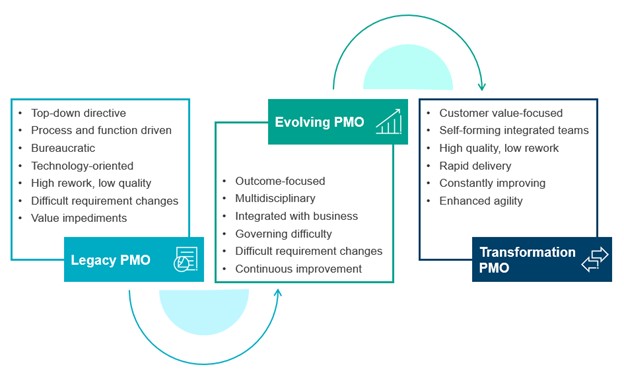Established enterprises and rapidly growing firms continue to adapt to changing business environments driven by competition, acquisitions, emerging technologies and new risks. The same changes that are transforming the project management role and skills, discussed in this previous blog, are also altering the program (or project) management office (PMO).
The need for alignment, built-in quality, transparency and ability to execute across multiple project initiatives is at an all-time high. Innovative design thinking, continuous delivery, high quality and relentless pursuit of improvement are some of the vital attributes a modern-day PMO must have to attain business priorities. Below, we explore the factors driving the PMO evolution and the seven factors needed to evolve a traditional PMO into a transformation management office (TMO).
Drivers Behind the PMO Evolution
Increased external business environment pressures require organizations to attain rapid and meaningful value from their projects and initiatives. For the PMO, this translates into shorter delivery cycles, use of emerging technologies and frequently shifting priorities. To attain this transformation, the PMO must shift its focus from methodology-driven project execution to value-driven business outcomes. The change drivers typically align to three key needs, as shown below:

For industry leaders – and especially those companies whose business strategy is digitally focused – rapid innovation is critical. For this reason, many forward-thinking PMOs have made it a top priority to adopt agile practices and enhance their capabilities to deliver the expected significant improvements in value. Agile has achieved critical mass, as both established companies and industry disruptors have made the leap successfully and adopted these methodologies. The Scaled Agile Framework (SAFe™), in particular, has gained popularity because it enables organizations to right-fit their PMO, meet the new business demands, remain competitive and retain market position.
Adopting new frameworks, methodologies and collaboration tools, as well as making significant investments in training people and implementing an enterprise-wide agile mind-set, are needed to evolve from a task-tracking legacy PMO to an outcome-focused PMO (one that is maturing but still rigidly governed) to an agile, customer-focused “transformation PMO” or TMO. Figure 1 below illustrates the transformation journey.
Figure 1 – The PMO transformation journey

Critical Factors to Consider
In our experience, four out of five organizations report using standardized project management practices such as a traditional PMO and waterfall methods. This holds true across industries.
However, the drivers we discussed earlier are causing many of these organizations to question their traditional project management methods’ ability to meet current business objectives. Protiviti has identified seven key factors we believe are critical for organizations to begin the TMO transformation journey while laying the foundation for adopting a right-fit agile framework, such as SAFe, at its core.
Leadership – Leaders need to fully embrace the TMO core values of alignment, built-in quality, transparency and program execution. They need to live the agile mind-set, emphasizing value, respect for people and culture, flow, innovation, and relentless improvement while fostering a culture of trust and safety when there are setbacks on the journey.
Organizational Agility – Program- and project-level processes need to be optimized around delivering value in the shortest sustainable time frame while enabling organizations to rapidly reorganize and adapt to changing priorities.
Lean Portfolio Management – Funding and execution priorities need to be aligned around workstreams that add value to business priorities. This enables organizations to optimize operations across their project portfolio. Program and project governance, oversight and decision-making should be decentralized to reduce overhead while increasing agility.
Enterprise Solution Delivery – The end-to-end software development life cycle needs to be aligned to a DevOps approach that refines and coordinates the work product across workstreams, supply chains and suppliers to attain and sustain continuous delivery.
Agile Product Delivery – Program delivery methods need to begin with a customer focus and design thinking while aligning the continuous-delivery pipeline to a release cadence that delivers optimized value for the customer.
Team and Technical Agility – Teams need to be high performing and cross-functional and have the knowledge and capability to apply effective agile principles to build and produce high-quality solutions and work products aligned to customer-focused business priorities.
Continuous-Learning Culture – Investing in becoming a learning organization is essential for transforming employees. Innovation and design thinking must be embraced to empower employees to explore and unlock future value. Continuous improvement of solutions, processes and products should be a focus across the entire organization at all levels.
Transition and Close
As globalization continues and technology innovation accelerates, the new challenges, complexities and demands for rapid value and speed to market will continue to increase. Companies must embrace the transformation PMO with scaled agile by aligning to meaningful value, built-in quality, transparency, and effective and efficient program execution to remain relevant with customers.
This blog was originally posted on The Protiviti View. To learn more about how Protiviti supports the project management function, contact us.






